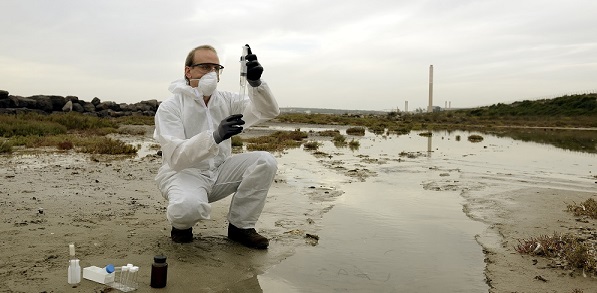
By Veena Clay May 4, 2015
Groundwater is one of the most precious resources on Earth. Its yields supply water to nearly every community in the country, and without it, most of us would be driven to drastic measures to accommodate drought conditions.In fact, that very situation is happening in communities across the nation. As groundwater is increasingly negatively affected by a number of environmental factors, communities are being left high and dry, literally, without enough water resources to support normal daily use.
That’s what makes the contamination of groundwater such an important and key issue. Whether it’s due to fracking chemicals or other sources of pollution like e-waste, groundwater contamination is a cause for great concern, and the number of communities having to address this complex issue is growing.
What is Groundwater?
The easiest way to define groundwater is to say it’s the opposite of surface water. Water from rain and the runoff from surface water sources, such as lakes, rivers and streams, find their way to underground aquifers, caves and other natural collection points deep beneath the Earth’s surface. Many communities drill down to tap into these water sources for daily water use. Those who live in rural areas often drill down to groundwater to create wells for their properties.Groundwater Contamination
Unfortunately, groundwater contamination and pollution is quite common. Due to water’s excellent solvency, it’s easy for runoff and even rainwater to contain contaminates from plastics, pesticides, oil and dissolved chemicals. All this eventually finds its way to groundwater resources and can accumulate over time. Groundwater contamination is especially prevalent at well-known hazardous waste sites such as chemical and petroleum plants or communities near them.Leaching E-waste
E-waste, too, can be one of the major pollutants of groundwater. Although many states have enacted landfill bans for most consumer electronics and appliances, the dangers associated with e-waste leaching remain.That’s because e-waste can contain a number of extremely hazardous and toxic substances, including mercury, lead and cadmium, among others. When electronic devices are not properly disposed, these substances can seep into soil and eventually find their way to groundwater resources just like other pollutants. The potential for e-waste to be a threat to groundwater quality is a major concern when electronics are dumped illegally and in states that have yet to enact landfill ban legislation for electronic waste.
A major part of that concern is the amount of mercury, lead and cadmium that e-waste can leach into soil affecting groundwater quality. Each of these are major components of most electronic devices including cell phones, laptops and tablets.
These devices are three of the most rapidly mass-produced electronics of our time, and such proliferation means more and more devices are also becoming obsolete on an increasingly frequent basis – and that means e-waste is mounting at a disconcertingly fast pace.
If those devices are not recycled or refurbished, they will find their way to the garbage, then the soil and eventually groundwater. With improper methods of e-waste disposal, such as illegal dumping, groundwater contamination is a likely result.
The Law and Groundwater Contamination
The EPA regulates the illegal dumping and export of e-waste as well as groundwater quality and set standards for safe drinking water for cities across the nation. When groundwater is contaminated, it’s the EPA that steps in to investigate and remedy the situation.For instance, the EPA has addressed a recent stint of illegal e-waste dumping from corporations. Companies like AT&T have been fined millions for dumping e-waste into landfills and other uncertified areas in violation of state laws and EPA regulations.
The EPA also regulates the illegal export of e-waste to foreign nations. When e-waste first began to be an overwhelming stream, a trend toward shipping excess electronics to underdeveloped nations quickly developed. Waste accumulated to disastrous levels in countries like Ghana and India where formal methods of recycling are lacking.
Many countries have now ratified the Basel Convention, which prohibits such shipments. Although the U.S. is one of the few countries that has not yet ratified the Basel Convention, many state laws and EPA regulations make such practices illegal and punishable by fines. The EPA has even raided recycling businesses suspected of engaging in illegal e-waste exports.
The EPA requires city landfills to monitor groundwater quality unless they can demonstrate that there is no potential threat of contamination.1 Landfills must implement a groundwater monitoring system consisting of a number of wells positioned around the uppermost aquifer in the region to collect samples of water for testing. These systems must be certified by groundwater scientist and meet all requirements of EPA regulations.
Lawsuits are also another inevitable result of groundwater contamination. Residents who refuse to sit idly by while their drinking water is rendered dangerous and hazardous to their health due to clandestine e-waste dumping are likely to take matters to court for compensation. However, lawsuits can’t fix the groundwater quality. For that, more extensive measures must often take place.
Is Clean-up Possible?
Not only is clean-up possible, it is required under EPA regulations when groundwater becomes contaminated. However, the process isn’t easy and hardly ever takes place overnight.According to the EPA, 80 percent of the most hazardous waste sites in the nation have contaminated nearby groundwater.2 Cleaning up these sites can be a costly process, with numbers escalating into the millions of dollars. To address this pressing issue, Congress enacted the Comprehensive Environmental Response, Compensation and Liability Act, or Superfund, which gathers funds, mostly from the taxes on the hazardous chemical and petroleum industries, to clean up contaminated sites.
However, even with federal funds available, groundwater clean-up can take several years or even decades to perform and, in some cases, cannot be completed. Instead, they must be contained in the safest manner possible.